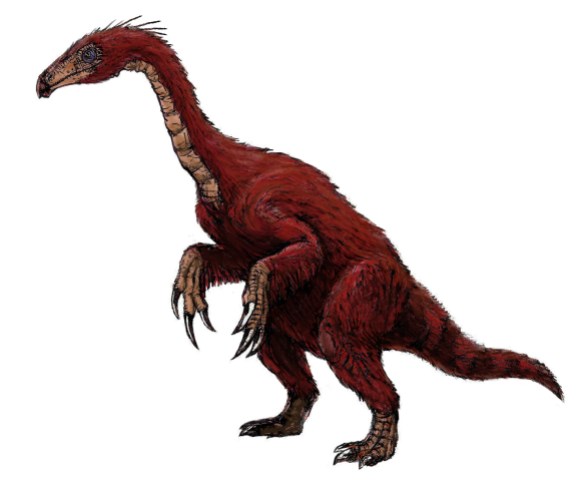
When I was a child, I had a scrapbook which I filled with pictures of extinct animals, especially dinosaurs. As I was unable to write myself, I asked my mom to copy text from some of my books on the subject, to make the scrapbook look more “real”.
I was fascinated by extinct animals, since no one had ever seen them alive, making them almost mythological. I later began drawing my own illustrations of extinct creatures, but by the time I reached my teens, this felt like an “uncool” waste of time.
Fast forward to my early twenties, when I began to casually edit Wikipedia articles, and became very impressed by the dinosaur articles there. I discovered that due to Wikipedia’s license policies, many dinosaur articles lacked illustrations, and this rekindled my interest in drawing dinosaurs: now there was a purpose to it! I started posting illustrations to WikiProject Dinosaurs’ image review page, where I got a crash-course in the latest dinosaur research by the local experts. I was surprised by the discoveries that had been made since I stopped paying attention to the field, but I did not feel confident enough in my knowledge to edit the article texts, so I stuck to adding illustrations and photographs, some self-made, and some “scavenged” on the web.
One amusing consequence of making free illustrations for Wikipedia was seeing them pop up in unexpected places. I recognised an illustration I made of the dinosaur Segnosaurus on a bootleg poster sold outside a Walking With Dinosaurs arena show, and noticed the same illustration in an exhibit at a Polish museum…

As the years went, I became increasingly familiar with the palaeontological literature through my activities on Wikipedia. I started buying books about dinosaurs and other extinct animals again, and I reached a point where I was able to identify unlabelled photos of museum specimens in free Flickr and Wikimedia Commons images, thereby making them useful for Wikipedia. Among the new books I had acquired was one about the extinct dodo. Looking at the bird’s Wikipedia article, I was baffled by the state it was in, considering how famous a species it was. To flesh out the article, I added a few 17th century quotes from travellers who encountered the bird, but the text still didn’t feel worthy of the subject.
The following summer, my girlfriend and I broke up, and my holiday plans went out the window. With nothing specific to do, I took a crack at summarising text from my dodo book in the Wikipedia article, mainly to make room for some interesting contemporary illustrations of the bird. After some days I was hooked, and I started to do the same in the article about the related and also extinct Rodrigues solitaire. After having expanded these articles, I got curious about nominating them for good and perhaps featured article status, but as a non-native speaker, I was unsure about the quality of my English writing. With support from editors at WikiProject Birds, the articles were promoted, and I felt encouraged to expand and nominate more articles about recently extinct birds—an otherwise quite neglected subject on Wikipedia, with only two prior featured articles, but also one where sources were easy to come by.
After some months, I had successfully nominated articles about most of the charismatic extinct bird fauna of the Mascarene islands, and I then began working my way towards other extinct animals, began co-writing articles with other editors, and finally felt confident enough in my writing to tackle dinosaur articles. I had felt uneasy with this subject because of the great work that had been done before me, so I started with Dromaeosauroides, a rather obscure dinosaur that nonetheless had sentimental value for me, as it is the only named dinosaur from my home country of Denmark. While writing the article, I also maintained an email correspondence with the palaeontologists who found and named the dinosaur; they gave me input when drawing the illustrations in the article.

Since then, writing and nominating Wikipedia articles about extinct animals of all sorts has been a stable hobby of mine, and I feel it is a direct continuation/evolution of the old scrapbook I kept as a kid. In a sense, I feel it is the closest that can be done to bring these animals back to life (short of cloning them, which will never be possible for most). If I really want to stretch my credit, it may even help spread awareness about conservation of living species that are threatened by human activities (many of the animals I’ve written about were exterminated by humans).
On a more personal level, it also acts as a substitute to a career in biology; my profession is animation, but natural history has always been a strong passion. I have come the closest to doing scientific research through my research for Wikipedia, including discovering formerly unnoticed (according to palaeontologist Julian Hume) historical illustrations of extinct birds, such as one in the National Gallery of Denmark showing two white dodos (painting at top).
So in short, Wikipedia reignited my childhood obsession with dinosaurs and other extinct animals. I’m thrilled when I can pass on any of that enthusiasm by improving the articles about them, thereby keeping these creatures alive in the collective memory.
FunkMonk, English Wikipedia contributor
“Why I …” is an ongoing series for the Wikimedia Blog. We want to hear what motivates you to contribute to Wikimedia sites: send us an email at digitalmedia [at] wikimedia [dot] org if you know of someone who wants to share their story about what gets them to write articles, take photographs, proofread transcriptions, or beyond.

Can you help us translate this article?
In order for this article to reach as many people as possible we would like your help. Can you translate this article to get the message out?
Start translation